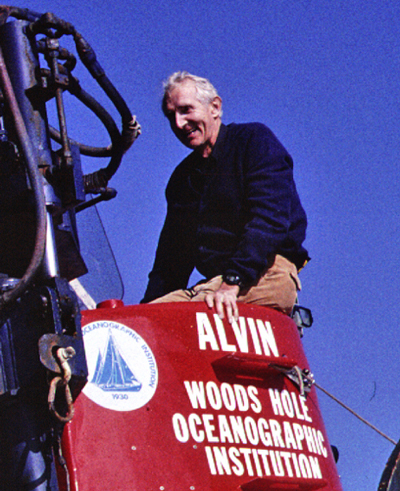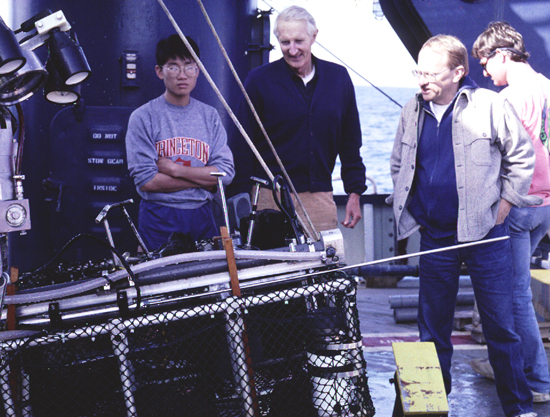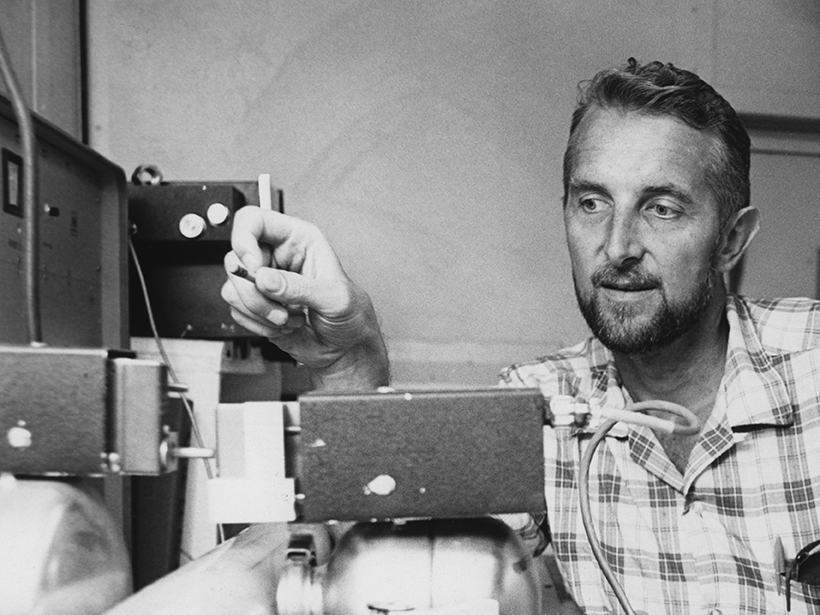Richard P. Von Herzen, 1998 Maurice Ewing medalist, American Geophysical Union (AGU) Fellow, and world-renowned geothermal scientist, passed away peacefully on 28 January 2016 at the age of 85. Dick had an incredibly positive influence on the careers of many marine geothermal scientists throughout the world. On behalf of his many colleagues and friends who feel the loss deeply like us, we wish to commemorate the many accomplishments of his distinguished career.
Dick earned his B.S. in geophysics at the California Institute of Technology in 1952, and after a tour of duty in the U.S. Army, earned his M.A. in geology at Harvard in 1956 and a Ph.D. at the Scripps Institution of Oceanography in 1960. He remained at Scripps for four more years as a research geophysicist, then moved on to a 2-year stint as deputy director of the United Nations Educational, Scientific and Cultural Organization’s Office of Oceanography in Paris.
“Dick virtually established marine heat flow as a discipline within marine geophysics.”
In 1966, he took a research scientist position at the Woods Hole Oceanographic Institution (WHOI), his professional base for the next 50 years. During the course of his career, Dick made many fundamental scientific contributions in marine geothermal research and also was a leading developer of the instrumentation needed for making geothermal measurements at sea. As Seiya Uyeda said so well in his citation when Dick was awarded the Maurice Ewing Medal in 1998, “Dick has virtually established marine heat flow as a discipline within marine geophysics.”
Dick was rigorous in his science and measurement techniques and was known throughout the community as a consummate, modest gentleman who thrived on collaboration and graciously mentored young scientists from WHOI and other institutions.
Early Studies of Seafloor Spreading
Dick led many of the seminal seafloor geothermal studies completed during the exciting 1960s–1970s period, when plate tectonics was being developed and accepted as a theory and also when hydrothermal circulation was discovered in young oceanic crust.
Dick’s 1959 letter to Nature and 1963 Journal of Geophysical Research paper with Seiya Uyeda on heat flow in the eastern Pacific first documented high values centered along the bathymetric rise that we now know as the East Pacific Rise spreading center. Dick and Seiya attributed this to “large-scale thermal convection in the mantle,” and these measurements provided important supporting evidence for the emerging concept of seafloor spreading.
Five years later, Dick was co–chief scientist with Art Maxwell on Deep Sea Drilling Project (DSDP) Leg 3, which famously validated seafloor spreading by dating the basal sediments on a transect of sites across the South Atlantic.
Pioneering Work on Hydrothermal Circulation

In the early 1970s, Dick and his student Dave Williams collected bottom water temperature profiles across the Galapagos Rise that provided the first evidence for the existence of hydrothermal plumes rising from spreading centers. Their spatial profiles of seafloor heat flow across the Galapagos Rise showed a regular variation with distance from the axis, which they interpreted as a result of cellular hydrothermal circulation within the oceanic crust, as had just been hypothesized by the University of Washington’s Clive Lister.
Following up in 1977, Dick was co-leader of the submersible expedition that returned to the Galapagos Rise and first discovered hydrothermal vents on the seafloor (relatively low temperature vents in this case) and their unique ecosystems.
In his fieldwork during the following decades, Dick continued to document hydrothermal circulation in young ridge flanks near a number of spreading centers, as well as the persistence of hydrothermal circulation in surprisingly old oceanic crust. With a number of coinvestigators, he also conducted several heat flow surveys to investigate geothermal processes associated with oceanic hot spots and swells, notably the Hawaiian Swell, the Bermuda Rise, and the Reunion hot spot track. In addition, he was one of the earliest to interpret sediment temperature profiles for evidence of recent changes in bottom water temperatures related to climate change.
Contributions in Heat Flow Instrumentation

In support of his geothermal fieldwork, Dick pioneered many instrumental developments that set standards still in use in the marine sciences. These were not necessarily hugely innovative in a technological sense, but he had a true talent for packaging equipment to make relatively straightforward measurements (e.g., temperature) rigorously and reliably under challenging deployment conditions.
His contributions in this vein included the following:
- with Art Maxwell, the needle-probe method to determine the thermal conductivity of marine sediments
- some of the earliest digital heat flow data loggers (which had also been developed independently by Clive Lister)
- multipenetration “pogo probe” heat flow instrumentation with real-time acoustic telemetry of data during measurements
- the short heat flow probes used by the U.S. research submersibles Alvin and Jason
- downhole probes to determine sediment temperatures during Project Mohole and in DSDP boreholes, including miniaturized temperature recorders inside the cutting shoes of the hydraulic piston corer as still used in scientific ocean drilling
Personal and Collegial Accomplishments
Dick was the great-great-grandson of the famous nineteenth century Russian novelist and political writer Alexander Herzen. He was an excellent athlete; during his military service, he swam the breaststroke leg for the gold medal U.S. Army relay team.
Dick and his beloved wife, Jan, were gracious hosts to many scientists who visited WHOI, as fondly remembered by both of us. Dick and Jan are survived by their two accomplished children, Brian and Lane; Brian’s life partner, Rebecca Truman; Lane’s husband, Ken MacWilliams; and two grandsons, Graham and Duncan MacWilliams.
One of Dick’s most enduring legacies is the positive and supportive influence he had on the careers of many younger geothermal scientists, some of whom honored his contributions in a February 1983 special section of Journal of Geophysical Research: Solid Earth. He graciously shared instrumentation and professional advice with all who sought him out.
Dick’s rigorous attention to detail set a standard for all of us involved in heat flow measurements at sea.
Dick’s rigorous attention to detail set a standard for all of us involved in heat flow measurements at sea. At the same time, his thoughtful and generous demeanor set a standard for collegial interactions. Dick exemplified the best traits of a mentor long before effective mentoring was identified as an academic expectation.
Those of us who were lucky enough to know and work with Dick deeply valued his friendship as well as his professional collaborations. We will miss him sorely, and we will remember and honor him as a visionary leader and one of our most influential colleagues.
—Keir Becker, Rosenstiel School of Marine and Atmospheric Science, University of Miami, Miami, Fla.; email: [email protected]; and John G. Sclater, Scripps Institution of Oceanography, University of California, San Diego, La Jolla
Citation: Becker, K., and J. G. Sclater (2016), Richard P. Von Herzen (1930–2016), Eos, 97, doi:10.1029/2016EO051415. Published on 27 April 2016.
Text © 2016. The authors. CC BY-NC 3.0
Except where otherwise noted, images are subject to copyright. Any reuse without express permission from the copyright owner is prohibited.

